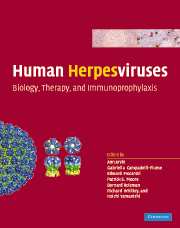Book contents
- Frontmatter
- Contents
- List of contributors
- Preface
- Part I Introduction: definition and classification of the human herpesviruses
- Part II Basic virology and viral gene effects on host cell functions: alphaherpesviruses
- Part II Basic virology and viral gene effects on host cell functions: betaherpesviruses
- Part II Basic virology and viral gene effects on host cell functions: gammaherpesviruses
- Part III Pathogenesis, clinical disease, host response, and epidemiology: HSV-1 and HSV-2
- Part III Pathogenesis, clinical disease, host response, and epidemiology: VZU
- Part III Pathogenesis, clinical disease, host response, and epidemiology: HCMV
- Part III Pathogenesis, clinical disease, host response, and epidemiology: HHV- 6A, 6B, and 7
- Part III Pathogenesis, clinical disease, host response, and epidemiology: gammaherpesviruses
- 50 Clinical and pathological aspects of EBV And KSHV infection
- 51 EBV: Immunobiology and host response
- 52 Immunobiology and host response to KSHV infection
- 53 The epidemiology of EBV and its association with malignant disease
- 54 The epidemiology of KSHV and its association with malignant disease
- 55 EBV-induced oncogenesis
- 56 KSHV-induced oncogenesis
- Part IV Non-human primate herpesviruses
- Part V Subversion of adaptive immunity
- Part VI Antiviral therapy
- Part VII Vaccines and immunothgerapy
- Part VIII Herpes as therapeutic agents
- Index
- Plate section
- References
55 - EBV-induced oncogenesis
from Part III - Pathogenesis, clinical disease, host response, and epidemiology: gammaherpesviruses
Published online by Cambridge University Press: 24 December 2009
- Frontmatter
- Contents
- List of contributors
- Preface
- Part I Introduction: definition and classification of the human herpesviruses
- Part II Basic virology and viral gene effects on host cell functions: alphaherpesviruses
- Part II Basic virology and viral gene effects on host cell functions: betaherpesviruses
- Part II Basic virology and viral gene effects on host cell functions: gammaherpesviruses
- Part III Pathogenesis, clinical disease, host response, and epidemiology: HSV-1 and HSV-2
- Part III Pathogenesis, clinical disease, host response, and epidemiology: VZU
- Part III Pathogenesis, clinical disease, host response, and epidemiology: HCMV
- Part III Pathogenesis, clinical disease, host response, and epidemiology: HHV- 6A, 6B, and 7
- Part III Pathogenesis, clinical disease, host response, and epidemiology: gammaherpesviruses
- 50 Clinical and pathological aspects of EBV And KSHV infection
- 51 EBV: Immunobiology and host response
- 52 Immunobiology and host response to KSHV infection
- 53 The epidemiology of EBV and its association with malignant disease
- 54 The epidemiology of KSHV and its association with malignant disease
- 55 EBV-induced oncogenesis
- 56 KSHV-induced oncogenesis
- Part IV Non-human primate herpesviruses
- Part V Subversion of adaptive immunity
- Part VI Antiviral therapy
- Part VII Vaccines and immunothgerapy
- Part VIII Herpes as therapeutic agents
- Index
- Plate section
- References
Summary
Introduction
The Epstein–Barr virus (EBV) is a human herpesvirus that is a ubiquitous infectious agent, infecting greater than 90% of the world's population (Henle et al., 1969). The majority of infections occur early in life without significant illness. However, EBV is clearly an important factor in multiple human cancers. This dichotomy raises the question as to what are the unique aspects of infection in those who develop cancers. The study of EBV and its associated tumors points to specific interactions between environmental, genetic, and viral factors.
Many of the malignancies associated with EBV develop in the setting of immunosuppression or have endemic patterns of incidence (Raab-Traub, 1996). EBV has potent growth transforming properties in vitro where it efficiently induces permanent growth of infected lymphocytes (Nilsson et al., 1971). Therefore it is not surprising that EBV is clearly the etiologic factor in post-transplant lymphoma and a subset of AIDS-associated lymphomas.
The endemic patterns of incidence characteristic of many EBV-associated tumors were initially apparent as EBV was originally isolated from samples of African Burkitt's Lymphoma (BL) (Epstein et al., 1964). This childhood tumor develops with high incidence in subequatorial Africa (Burkitt, 1962a). EBV was subsequently identified in nasopharyngeal carcinoma (NPC), a major tumor that occurs with extraordinarily high incidence in the southern Chinese and with elevated incidence in Inuit populations and in Mediterranean Africa (Henle et al., 1978a; Wolf et al., 1973).
- Type
- Chapter
- Information
- Human HerpesvirusesBiology, Therapy, and Immunoprophylaxis, pp. 986 - 1006Publisher: Cambridge University PressPrint publication year: 2007
References
- 16
- Cited by

